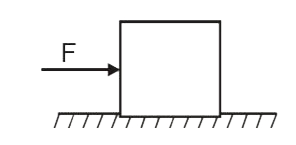A block of mass 5 kg is resting on a smooth surface at what angle a force of 20 N be acted on the body so that it will acquire a kinetic energy of 40 J after moving 4 m?
300
450
600
1200
The correct Answer is:C
To solve the problem, we need to determine the angle at which a force of 20 N must be applied to a 5 kg block so that it acquires a kinetic energy of 40 J after moving 4 m.
1. Understand the Problem:
We have a block of mass m=5kg resting on a smooth surface. A force F=20N is applied at an angle θ to the direction of displacement. The block moves a distance d=4m and acquires a kinetic energy KE=40J.
2. Apply the Work-Energy Principle:
According to the work-energy principle, the work done on the block is equal to the change in its kinetic energy:
W=ΔKE
Since the block starts from rest, the initial kinetic energy is 0. Therefore:
W=KE=40J
3. Calculate the Work Done:
The work done by the force can be expressed as:
W=F⋅d⋅cos(θ)
Substituting the known values:
40=20⋅4⋅cos(θ)
4. Simplify the Equation:
Simplifying the equation gives:
40=80⋅cos(θ)
Dividing both sides by 80:
cos(θ)=4080=12
5. Find the Angle:
The angle θ for which cos(θ)=12 is:
θ=60∘
6. Conclusion:
Therefore, the angle at which the force must be applied is 60∘.
Final Answer:
The angle θ is 60∘.
We have a block of mass m=5kg resting on a smooth surface. A force F=20N is applied at an angle θ to the direction of displacement. The block moves a distance d=4m and acquires a kinetic energy KE=40J.
According to the work-energy principle, the work done on the block is equal to the change in its kinetic energy:
W=ΔKE
Since the block starts from rest, the initial kinetic energy is 0. Therefore:
W=KE=40J
The work done by the force can be expressed as:
W=F⋅d⋅cos(θ)
Substituting the known values:
40=20⋅4⋅cos(θ)
Simplifying the equation gives:
40=80⋅cos(θ)
Dividing both sides by 80:
cos(θ)=4080=12
The angle θ for which cos(θ)=12 is:
θ=60∘
Therefore, the angle at which the force must be applied is 60∘.
The angle θ is 60∘.
Similar Questions
A block of mass 5kg is resting on a rough surface as shown in the figure. It is acted upon by a force of F towards right. Find frictional force acting on block when 25N.

View SolutionA block of mass 5kg is on a rough horizontal surface and is at rest. Now a force of 24 N is imparted to it with negligible impulse. If the coefficient of kinetic friction is 0.4 and g=9.8m/s2 , then the acceleration of the block is
View Solution
Knowledge Check
A block of mass 5 kg is resting on a smooth surface. At what angle a force of 20 N be acted on the body so that it will acquired a kinetic energy of 40 J after moving 4 m?
A30∘B45∘C60∘D120∘A block of mass 2 kg is resting on a smooth surface. At what angle a force of 10 N be acting on the block so that it will acquire a kinetic energy of 10 J after moving 2 m
A30∘B45∘C60∘D90∘A force of 75 N is applied to a block of mass 25 kg, resting on a smooth horizontal surface. In how much time, the block will acquire a speed of 12 m/s?
A1 secB2secC4 secD8 sec
A block of mass 5kg is initially at rest on a rough horizontal surface. A force of 45N acts over a distance of 2m. The force of friction acting on the block is 25N. The final kinetic energy of the block is
View SolutionA block of mass 0.50kg is moving with a speed of 2.00m/s on a smooth surface. It strikes another mass of 1kg at rest and they move as a single body. The energy loss during the collision is
View SolutionA block of mass kg 5 is moving horizontally at a speed of 1.5m/s . A perpendicular force of 5 N acts on it for 4 sec. What will be the distance of the block from the point where the force started acting
View SolutionA block of mass 0.50 kg is moving with a speed of 2.00 m/s on a smooth surface. It strikes another mass of 1.00 kg and then they move together as a single body. The energy loss during the collision is
View SolutionA block of mass M is hanging over a smooth and light pulley through a light string. The other end of the strinig is pulled by a constant force F. The kinetic energy of the block increases by 20J n 1s.
View Solution
